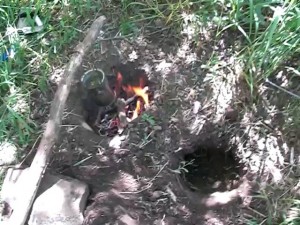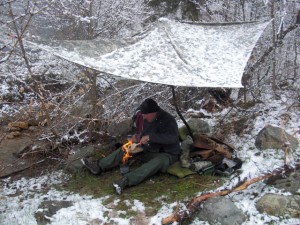How do I Know, When does Survival start?
This may seem like an odd question to ask, yet the answer and it's timing can make the difference in life or death. In a previous blog I wrote about paradigm shifts, which is basically to say we change our view of things when we go into
survival mode. Delaying this shift in thinking can cause fatal procrastination in shelter building, obtaining water, or personal care. So just how do we know when to shift into
survival mode? Let me illustrate this with a story of an event that happened to me last week.
I had recently found a canyon to ride my mountain bike in that had a great trail, twists, turns, creek crossings and all. I had been on the trail a couple times already and wanted to explore further on each of it's two forks. It had snowed and rained the previous couple of days and although most of the snow was melted, there were still patches everywhere. The stream, now many times it's normal size with snow melt runoff, was still passable.
I rode my bike further up the left fork than I had previously been, and shot a couple of videos for use on our
YouTube channel. The sun had gone down while I was just getting started, due to the steep canyons, but I still had time to ride in the daylight.
I was
dressed for cool weather, my 60/40 pants, wool socks, a Tee shirt, and a cotton hoodie, I also had a fleece cap in my Camelback. On my handle bars I had secured as usual my
Wilderness Innovation Off-Road Survival Kit.
On the ride up the canyon, I had for the most part portaged my bike across the stream, due to the high water, there were about 15 crossings to be made. When I started back down I figured to ride most of the crossings, being that I was going downhill anyway and would have some momentum with me.
I made the first few crossings nicely, then there was a long traverse as the trail descended, soon I came upon my next crossing, it was deep, but looked doable and I continued into the water. At that moment I noticed something in the water, a large pothole midstream, which at this point was too late to do anything about. In an instant
I was thrown over my handle bars and headlong into the icy water. I suddenly stopped as my right shoulder hit on a boulder under water. I felt sharp pain. The water was flowing over me as I struggled to get up, not being able to use my right arm.
As I was able to get up I saw, my bike upside down, wheels in the air. I noticed my Survival Kit still fastened on the handle bars. I dragged the bike and myself to shore. My right knee was hurting pretty bad. One of my first thoughts was, if I can't make it out I will have to start a fire soon, to get warmed and dry out. The air was already beginning to chill into the 30's. It was a relief to know I had the
survival kit, at least I could get a fire going and get some basic shelter if I needed to.
I determined that if I could get out of the canyon to my truck that would be best. I would start down and see how I did, if I felt like I couldn't continue, then a bivouac would be made for the night.
My shoulder was dislocated, so I knew I needed to try to get that fixed, and after swinging my arm around a bit it popped into place. Now how was my knee? It really hurt to walk on it, but I figured if I could get onto my bike, I should be able to coast most of the way down and would only have to walk the crossings. That seemed to work, but the shoulder pain was intense and my right arm was only used mostly for the brakes.
I was able to successfully get out, I was pretty cold, sore and in pain, but I made it. As I reflect back I am pleased to note that instinctively, one of
my first thoughts was sheltering up for the night. I was ready to stay the night, I had to talk myself into continuing down. I felt good that I made the shift to
survival mode at once, automatically, I would not risk further danger by continuing if it wasn't safe.
Train yourself to be ready, not to go on, but to stay and to shelter if that's the safest thing to do. Avoid the need to press on, sometimes it can be deadly.
Until next time - Perry Peacock, "Simplifying Survival"


